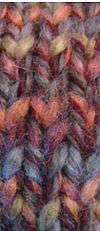Fully fashioned knitting
Fully fashioned knitting machines are those flat and circular knitting machines that produce custom pre-shaped pieces of a knitted garment. Instead of knitting a whole rectangular sheet of fabric, instructions from a knit pattern on a punch card or computer file guide a fully fashioned knitting machine's needles to add or drop stitches to create custom two-dimensional shapes appropriate to the desired finished garment structure. The pieces emerge from the machine ready to be sewn together.
Fully fashioned knitting cuts down on the amount of material required to make a garment by eliminating selvage, the remnants that would be left after cutting from a rectangular fabric sheet. For example, a sweater requires at least four pieces of fabric: two sleeves, the front piece, and the back piece. Prior to fully fashioned machine techniques, a full sheet of material would have to be produced, each of the four pieces would be cut out, and the remaining fabric would be discarded. With full-fashioning, the machine produces only the four required pieces.
The necessary techniques for changing the fabric width or diameter are achieved by:
- changing knit structure (e.g. rib to interlock)
- varying the structural elements (stitch length, weft insertion, knit, tuck, float)
- shaping through loop transfer
- wale fashioning by 'needle parking,' and
- segmented takedown for varying rates of takedown across the width of the fabric.
These knit options above may also be used to change the structure of each piece to create limited curvature (such as convexity at the bust of a sweater) in the relatively two-dimensional output. A new generation of fully fashioned machines, called complete garment knitting machines, output seamless three-dimensional garments by knitting connected tubular forms.
